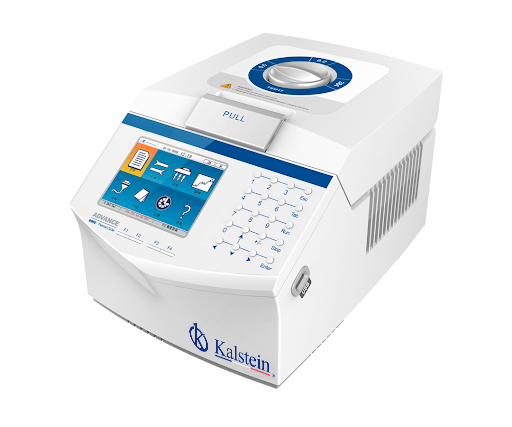PCR is a simple and widely used procedure in the expansion of DNA, which is essential in any laboratory, as it is more effective and faster,as in the diagnosis of diseases such as COVID-19, HIV or cancer, allowing early arrest to avoid the spread of infections, and also establish treatments that improve the quality of life of patients.
This PCR technique is widely used in scientific research and molecular biology,the PCR reaction, requires the presence of DNA mold, primers, nucleotides and DNA polymerase,these components meet certaincharacteristics and functions that allow the machine or Thermocycler to produce repeated cycles of AMPLIFICATION of AND.
How the PCR Thermocycler works?
The device or equipment to amplify the DNA, is a Thermocycler, with a thermal block with water holes, in which the test tubes are placed, then the Thermocycler raises and lowers the temperature of the block in three basic stages already programmed by the user; the first reaction is heated above the denaturation point of the two complementary DNA strands of the target DNA, causing the strands to separate.
Then the temperature is lowered so that the specific primers bind to the target DNA segments, this process is called hybridization, then the temperature is raised again so that the DNA polymerase is able to extend the primers by adding nucleotides to the DNA strand that is being built.
Operation of the Thermocycler
This type of device generally has two types of ways to operate, the first is by means of an electrical resistance block, in this way the temperature is distributed constantly in adjustable time lapses, normally temperatures vary between 4 and 90 ° C; thus allowing the DNA to lose its natural properties and being possible the separation of the strands required to perform the analysis.
Then recently a new modality called Peltier technology appeared, this time the temperature changes are made through an electrical voltage, and its main function is to produce electricity that is transformed into high or low temperatures; in the Thermocycler there are two semiconductors by Peltier joints that makes this process possible; it has its advantages such as efficiency and accuracy with respect to samples and results.
Description of the technique used in PCR Thermocyclers
These devices perform a complete cycle that increases or decreases the temperature of a block, to improve the transmission of the temperature the tubes of 0.2-0.5 ml have the conical base a very thin wall to prevent condensation inside the tube, the Thermocyclers heat the tube cap during the process; the PCR ends with a final cycle of extension at 72°C of about 10 minutes to ensure that the chain DNA Simple be completed with the complementary strand.
Once the action is finished, the thermocycler block is at 4°c waiting to collect the tubes and run an aliquot of their contents in an agarose gel and thus check if the expected size fragment has been amplified correctly; the results of a PCR depend on the degree of degradation of the original DNA, the existence of inhibitors of the reaction and the similarity of the primers.
Precautions for use of the PCR Thermocycler
- You must wear clothing and face shield and control the intensity of the equipment, which can be the maximum with water and the minimum if agarose gel is used, there must be a reference table that shows the times of each position of the potentiometer and the amounts to be used.
If you want to know in depth how this equipment works and the different models of Thermocycler, KALSTEIN as a manufacturer of laboratory equipment we offer you visitarnos in the following link Kalstein, and you can clarify all possible doubts when acquiring a Thermocycler; we KALSTEIN will offer you the best advice in addition to the best online purchase and sales offers that you can find internationally, in addition to having the best technical service for the preventive maintenance of these equipment,if you have a laboratory you must acquire a Thermocycler immediately. HERE

